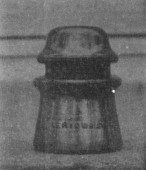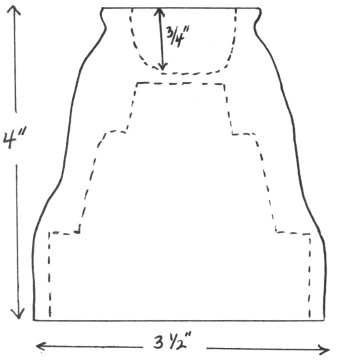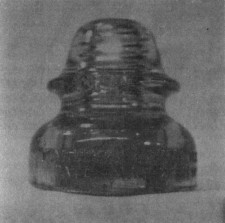Research Division
Reprinted from "INSULATORS - Crown Jewels of the Wire", May 1976, page 21
This is a picture of a Hemingray 17 I found in the crawl space under a
friend's house. He couldn't remember where it came from, but thought it might
have been a dump in Wyoming. The finish on the insulator appears to be the
typical brushed amber that Hemingray used. If you have the insulator in a
subdued light it appears to have a carnival sheen.

There is still some crud from
the wire insulation in the wire groove, and when I scraped a piece off, the
coating was under the crud. This gives me a reason to believe it is real--not a
painted up fake. I would like to know if there have been any others found.
Sincerely,
Ted Thompson
1920 Columbine
Boulder, CO 80302
- - - - - - - -
The colored picture Ted sent does show a carnival sheen to this insulator.
No, I have not seen any like this. Have you readers?
Dear Dora,
I have written several times in the past either about a subscription or some
other small problem, but I've never taken the time to express myself. I guess
the loss of our friend M. Milholland made me stop to count my blessings.
I want to thank you and Don for everything you both have done for me and all
hobbyists who take your little jewel of a magazine. Without both of you, what
would we do?
In nearly three years of collecting I've never attended a National meet; this
has "gota" be my year. I also would like to have a N.I.A. (National
Insulator Association) sanctioned meet the latter part of 1976 or early '77.

I am enclosing a snapshot of a little jewel that I found locally, on one of
the oldest railroad lines in our city. It is identically the size of CD 133.2,
but not listed in M. M. 3rd Rev. or '76 Price List. It is embossed: F-skirt- No
name Patent Dec 19,1871; B- 3 over D.
The date is patent #122,015/Robert Hemingray; the #3, probably a mold number;
the "D", well , HELP! It also appears to be made of used glass with
small debris and bubbles.
Good Collecting!
Bud Truan
4505 Cobblestone Circle
Knoxville, TN 37918
- - - - - - - - -
Dear Bud,
Thank you so much for writing, and we do appreciate all your kind words. It
makes all the effort put into Crown Jewels worthwhile. When we received your
letter about this insulator we were fortunate enough to have Glenn Drummond of
Cincinnati, Ohio, Executive Secretary of the N.I.A. and also a specialist in
Hemingray Patented 1871 insulators, visiting in our area, so I asked him for
help in answering your question about this CD 133 or 133.2. Following is his
answer.
Dora
- - - - - - - - - -
While the insulator you describe is very similar to the CD 133.2, it is
cataloged in Milholland's 3rd edition under the CD 133 category (see page 101,
line 9). This entry was inadvertently omitted from the 1976 price guide. The
price varies from about $3 for an aqua to about $12 for a pale blue
The number 3 refers to the Hemingray catalog style number. Yours is the
third in a series of Hemingray number 3's. The letter "D" is open to
question, however. While some "experts" claim this is a mold
identification, slight variations in letter embossing and placement make this
unlikely. Others suggest the letter identifies the work shift, and was used as a
means of paying the crews. Because some of the 1871's, especially the No. 4's
are found with only an "A", this explanation seems unlikely also. We
will probably never know, since no records of the Covington production exist.
Glenn Drummond
Dear Editor,
Please send me a copy of the latest issue and one copy of the February 1976
issue. I saw a copy of the February issue owned by Eugene Kalkwarf, and want one
for my own collection because of the article on "Bee Hives". I have
approximately 200 different insulators, including a Hemingray No. 8 amber in
mint condition. Can find no info on this insulator and would appreciate knowing
more about it.
Sincerely,
J. P. Howland
4035 "M"
Lincoln, NB 68510
- - - - - - - - -
Dear J. P.,
There's not much I can tell you about your CD 112.4 Hemi No. 8 in amber,
except that it is a highly desirable piece of glass. It seems there aren't too
many around, and they are seldom seen on lists of insulators "for
sale". Milholland's 1976 Pricing Guide lists the amber at $300.00.
Your Editor
I saw Jim Woods' report of the CD 152 "B" blackglass in the
February 1976 issue, page 11. I have one of these that I picked up for $2. It's
a very interesting color, like Coca Cola, but almost opaque. I've heard the full
"Brookfield' embossing also comes in this color, but haven't seen one.
H. G. "Bea" Hyve's piece on H. G. Co. Petticoats was great,
Paul Thornquist
Milwaukee, Wisconsin

This is a piece of glass I acquired and believe to be an insulator of some
type. It is a two piece mold, dark blue in color with amber swirls, a really
beautiful color. It is also full of air bubbles. It has no threads, and the
pin hole is only about an inch deep. The top is flat and has a round hole 3/4 of
an inch deep, but the hole doesn't go clear through. If you have any
information on this, would appreciate it.
Jim Parker
1004 N. Mulberry St.
Mt. Vernon, Ohio 43050
- - - - - - - - -
Here's another oddity I have no answer for. Sorry.
Dora
Dear Dora:
The writer of the article "H. G. Co. Petticoat Beehives" is to be
commended for the time and effort devoted to its preparation. The writer is also
to be commended for carefully pointing out those aspects of the article that are
opinion and speculation. I am very well aware of the frustrations one encounters
in attempting to write about the Hemingray operations. This is true for those of
us who live right at the scene; so I can only imagine the agony and headaches
one who is far removed must contend with. It is tragic that no personal papers
of either the Gray or Hemingray families are known to exist. To develop a story
or history, one must dig through directories, trade journals, and newspapers of
the era. Much of the information from these sources is incomplete and
conflicting, particularly as time went by. One has to continuously cross
reference to eliminate incorrect statements and slowly build up the base of
factual information. Writers of general purpose publications about the history
of "American glass" seem to be the worst offenders for perpetuating
misinformation. They excuse this by claiming they do not have time to research
each company and must rely on accepted reports of their predecessors. I can
accept this. However, it is unfortunate, because history gets truly bent out of
shape through this approach.
There are three of us here in the Cincinnati area who have spent considerable
time and effort researching the Hemingray operation in Cincinnati and Covington.
John Webster of Erlanger, Kentucky, has approached the research from Hemingray's
production of fruit jars and bottles. Mrs. Ester Powers of Cincinnati has looked
at the overall operations of the plant. My personal interest and attention has
been devoted to the early years of the Hemingray saga. By this I mean the years
beginning with the opening of the glass works in Cincinnati through about 1880.
Obviously I have encountered bits and pieces of information pertaining to the
later years, and I have recorded and filed these, but have never really made a
study of it.
The Gray and Hemingray glass works was making both telegraph and lightning
rod insulators soon after the shop opened in 1848 on Hammond Street in
Cincinnati. There is a vague reference that the insulator market is the reason
the Gray and Hemingray brothers chose to locate their business in Cincinnati. To
date none of us has been able to verify which telegraph and lightning rod
insulators were made at that time. As for threaded insulators, Hemingray
marketed his first production in May 1869. Two insulators were made at that
time, the unembossed CD 127 and CD 131.4.
I don't understand the writer's comment about dating the beehives to 1890 by
the mold marks. One can generally date-group the early Hemingray insulators as
1869-1881, 1881-1909, by the thread plunger marks. Because of the marks on the
"new" 1871 CD 120 No. 5's and CD 133 No. 3's there is evidence that mold
separation just above the wire groove began with the introduction of the 1881
threading press. However, continuation of the preceding mold design with
separation high on the dome is seen on the CD 124 No. 13 manufactured well after
1900.
Robert Hemingray's 1871 patent was not "distinctly different". In
fact, he was challenged by Homer Brooke to have the patent invalidated. After a
long series of hearings and appeals that were finally resolved in July 1873, the
Patent Office Commissioner decided in favor of Brooke, although Hemingray's
patent was allowed to stand. Since Brookfield was using Brooke's machine, all of
the early threaded insulators were manufactured by a "very similar"
device.
One bit of misinformation that I would like to put to rest is that the
Covington works was destroyed by a flood in 1919. The highest river stage
throughout that year was about nine feet below the lowest point on the company
grounds. As a matter of fact, the 1937 flood (the flood of record on this reach
of the Ohio) did not destroy the plant. Water was a little more than 13 feet
above the foundation, and much of the buildings remain today. However, the
business was certainly affected by the floods of 1883 and 1884 which peaked at
six and eleven feet above the foundation respectively. The effects of these
floods no doubt entered into the decision to relocate at Muncie. I have evidence
that production was discontinued at the Covington plant prior to 1904. Quite
frankly, I haven't made much effort to determine exactly when production ceased
at Covington. I suspect that 1898, when Robert Hemingray turned the Company over
to his son Ralph who had been living in Muncie for about 10 years, would be a
good guess for the end of Covington production.
When did Hemingray begin using the H. G. Co. embossing? Unfortunately, he did
not bother to register this mark with the Patent Office. Some soda and beer
bottles that can be dated to the early 1880's are embossed "H.G. Co."
on the base. There is some evidence, though very little, that the mark may have
been introduced on insulators when new molds were made for the 1881 threading
press. One of the most puzzling aspects of this story is why no insulator is
found with the 1871 patent date and the H.G. Co. embossing. This is especially
interesting because the number of styles that have both the 1871 and 1893 dates
and the CD 124 No. 4 which has both dates and "HEMINGRAY". The
application to register "HEMINGRAY" as a trade mark indicates its use
was begun in 1900. I am puzzled by the statement: "--- it is known that
later units made at Covington --- were embossed "H" or "H.G.
Co." If the writer means the CD 145 with only a large, heavy "H"
on the dome or the machine-style embossed "H.G. Co.", then I must
disagree, since it is reasonably evident that those insulators were made after
1909, which would have been from the Muncie plant.
James Gill first appears on the scene in 1884 as a mold maker. Before moving
to Muncie in 1890, he had advanced to become foreman of the mold shop. He
continued in this role at Muncie and was never an officer of the company. There
is just no way that the "H.G. Co." embossing can be interpreted as
Hemingray/Gill. Let us also put this bit of misinformation away for keeps.
I don't see how anyone could seriously suggest that color variety was rare in
the early Hemingray production. I will match our "1871" collection
against any collection on the basis of color. One will find all the colors in
the writer's list among the 1871's, plus cobalt blue, but excepting the various
shades of amber. If anything, the Muncie production was rather drab compared to
the Covington glass. One cannot date the clear H.G.'s to Muncie because we have
1871's that are as clear as any glass produced today. I have seen bottles that
were produced in the Gray and Hemingray era that are without any tint
whatsoever. The writer paints a pretty dismal picture of the glass works and
wonders how any insulators were made without defects. While even today, glass
shops are not the most comfortable of places to work, the Hemingray company had
a reputation in its time for quality products. The quality of their insulators,
which certainly didn't demand the controls required of the bottles, jars, lamps,
etc., was good enough that the telegraph companies were more than pleased. There
simply is no evidence that the H.G. Co.'s were a second-best line. All evidence
points to this embossing as a transition between the "1871"
identification and the "HEMINGRAY" embossing.
I don't agree with the writer's interpretation of the skirt letters as mold
identification marks. On the other hand, I can't support any other concept with
more than opinion, so I will leave this point in question. The writer states
that several collectors have sets of A through Z. This is interesting, since I
know of no one in this area who has found any letter beyond N.
It is hoped that these comments have added to the background of our hobby.
Sincerely,
Glenn Drummond

Dear Don & Dora,
Here is a picture of a Locke insulator that I have acquired. It is triple
Petticoat, measures 3-1/2" wide at base, and is 3-5/8" high. The color
is H. grayish-blue. It is damaged, as you may be able to see in the photo. I
am glad to have it, as I haven't seen another one like it. The insulator is
embossed as follows:
F. M. LOCKE VICTOR. N.Y.
PATD MAY 22 1894
Sincerely,
George F. Lahm
Callicoon, N.Y.
| 